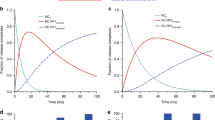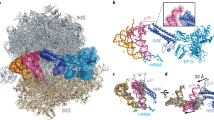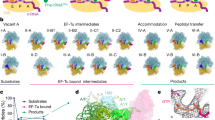Abstract
Protein synthesis takes place on the ribosome, where genetic information carried by messenger RNA is translated into a sequence of amino acids. This process is terminated when a stop codon moves into the ribosomal decoding centre (DC) and is recognized by a class-1 release factor (RF). RFs have a conserved GGQ amino-acid motif, which is crucial for peptide release and is believed to interact directly with the peptidyl-transferase centre (PTC) of the 50S ribosomal subunit1,2. Another conserved motif of RFs (SPF in RF2) has been proposed to interact directly with stop codons in the DC of the 30S subunit3. The distance between the DC and PTC is ∼73 Å. However, in the X-ray structure of RF2, SPF and GGQ are only 23 Å apart4, indicating that they cannot be at DC and PTC simultaneously. Here we show that RF2 is in an open conformation when bound to the ribosome, allowing GGQ to reach the PTC while still allowing SPF–stop-codon interaction. The results indicate new interpretations of accuracy in termination, and have implications for how the presence of a stop codon in the DC is signalled to PTC.
This is a preview of subscription content, access via your institution
Access options
Subscribe to this journal
Receive 51 print issues and online access
$199.00 per year
only $3.90 per issue
Buy this article
- Purchase on Springer Link
- Instant access to full article PDF
Prices may be subject to local taxes which are calculated during checkout



Similar content being viewed by others
References
Kisselev, L. L. & Buckingham, R. H. Translational termination comes of age. Trends Biochem. Sci. 25, 561–566 (2000)
Zavialov, A. V., Mora, L., Buckingham, R. M. & Ehrenberg, M. Release of peptide promoted by the GGQ motif of class 1 release factors regulates the GTPase activity of RF3. Mol. Cell 10, 789–798 (2002)
Ito, K., Ebihara, K. & Nakamura, Y. A tripeptide anticodon deciphers stop codons in messenger RNA. Nature 403, 680–684 (2000)
Vestergaard, B. et al. Bacterial polypeptide release factor RF2 is structurally distinct from eukaryotic eRF1. Mol. Cell 8, 1375–1382 (2001)
Zavialov, A. V., Buckingham, R. H. & Ehrenberg, M. A posttermination ribosomal complex is the guanine nucleotide exchange factor for peptide release factor RF3. Cell 107, 115–124 (2001)
Wimberly, B. T., Guymon, R., McCutcheon, J. P., White, S. W. & Ramakrishnan, V. R. A detailed view of the ribosomal active site: the structure of the L11–RNA complex. Cell 97, 491–502 (1999)
Gerstein, M., Lesk, A. M. & Chothia, C. Structural mechanisms for domain movements in proteins. Biochemistry 33, 6739–6749 (1994)
Ramakrishnan, V. Ribosome structure and the mechanism of translation. Cell 108, 557–572 (2002)
Tate, W. P., Dognin, M. J., Noah, M., Stöffler-Meilicke, M. & Stöffler, G. The NH2 terminal domain of Escherichia coli ribosomal protein L11. J. Biol. Chem. 259, 7317–7324 (1984)
Brot, N., Tate, W. P., Caskey, C. T. & Weissbach, H. Requirement for ribosomal proteins L7 and L12 in peptide-chain termination. Proc. Natl Acad. Sci. USA 71, 89–92 (1974)
Arkov, A. L. & Murgola, E. J. Ribosomal RNAs in translation termination: facts and hypothesis. Biochemistry (Moscow) 64, 1354–1359 (1999)
Seit-Nebi, A., Frolova, L., Justesen, J. & Kisselev, L. Class-1 translation termination factors: invariant GGQ minidomain is essential for release activity and ribosomal binding but not for stop codon recognition. Nucleic Acids Res. 29, 3982–3987 (2001)
Song, H. et al. The crystal structure of human eukaryotic release factor eRF1—mechanism of stop codon recognition and peptidyl-tRNA hydrolysis. Cell 100, 311–321 (2000)
Nissen, P., Hansen, J., Ban, N., Moore, P. B. & Steitz, T. A. The structural basis of ribosome activity in peptide bond synthesis. Science 289, 920–930 (2000)
Yusupov, M. M. et al. Crystal structure of the ribosome at 5.5 Å resolution. Science 4, 897–902 (2001)
Drugeon, G. et al. Eukaryotic release factor 1 (eRF1) abolishes readthrough and competes with suppressor tRNAs at all the three termination codons in messenger RNA. Nucleic Acids Res. 25, 2254–2258 (1997)
Tate, W. P., Greuer, B. & Brimacombe, R. Codon recognition in polypeptide chain termination: site directed cross linking of termination codon to Escherichia coli release factor 2. Nucleic Acids Res. 18, 6537–6544 (1990)
Wilson, K. S., Ito, K., Noller, H. F. & Nakamura, Y. Functional sites of interaction between release factor RF1 and the ribosome. Nature Struct. Biol. 7, 866–870 (2000)
Ito, K., Ebihara, K., Uno, M. & Nakamura, Y. Conserved motifs in prokaryotic and eukaryotic polypeptide release factors: tRNA-protein mimicry hypothesis. Proc. Natl Acad. Sci. USA 93, 5443–5448 (1996)
Jelenc, P. C. & Kurland, C. G. Nucleoside triphosphate regeneration decreases the frequency of translation errors. Proc. Natl Acad. Sci. USA 76, 3174–3178 (1979)
Frank, J. et al. SPIDER and WEB: processing and visualization of images in 3D electron microscopy and related fields. J. Struct. Biol. 116, 190–199 (1996)
Orlova, E. V. et al. Structure of keyhole limpet hemocyanin type 1 (KLH1) at 15 Å resolution by electron cryomicroscopy and angular reconstitution. J. Mol. Biol. 271, 417–437 (1997)
Gabashvili, I. S. et al. Solution structure of the E. coli 70S ribosome at 11.5 Å resolution. Cell 100, 537–549 (2000)
Jones, T. A., Zhou, J. Y., Cowan, S. W. & Kjeldgaard, M. Improved methods for building protein models in electron density maps and the location of errors in these models. Acta Crystallogr. A 47, 110–119 (1991)
Nissen, P., Hansen, J., Ban, N., Moore, P. B. & Steitz, T. A. The complete atomic structure of the large ribosomal subunit at 2.4 Å resolution. Science 289, 905–920 (2000)
Wimberly, B. T. et al. Structure of the 30S ribosomal subunit. Nature 407, 327–339 (2000)
Yusupova, G. Z., Yusupov, M. M., Cate, J. H. & Noller, H. F. The path of messenger RNA through the ribosome. Cell 106, 233–241 (2001)
Carson, M. Ribbons 2.0. J. Appl. Cryst. 24, 103–106 (1991)
Acknowledgements
We thank M. Kjeldgaard (University of Aarhaus, Denmark) for pre-releasing the RF2 coordinates, T. Tenson (Tarfu University, Estonia) for a critical reading of the manuscript and helpful suggestions, and M. Watters for assistance with the illustrations. This work was supported by the Howard Hughes Medical Institute and by grants from the National Institute of Health (to J.F.) and by the Swedish Foundation for Strategic Research and the Swedish Research Council (to A.V.Z. and M.E.).
Author information
Authors and Affiliations
Corresponding author
Ethics declarations
Competing interests
The authors declare that they have no competing financial interests.
Rights and permissions
About this article
Cite this article
Rawat, U., Zavialov, A., Sengupta, J. et al. A cryo-electron microscopic study of ribosome-bound termination factor RF2. Nature 421, 87–90 (2003). https://doi.org/10.1038/nature01224
Received:
Accepted:
Issue Date:
DOI: https://doi.org/10.1038/nature01224
This article is cited by
-
Visualization of translation termination intermediates trapped by the Apidaecin 137 peptide during RF3-mediated recycling of RF1
Nature Communications (2018)
-
Structural basis of co-translational quality control by ArfA and RF2 bound to ribosome
Nature (2017)
-
X-ray structure determination using low-resolution electron microscopy maps for molecular replacement
Nature Protocols (2015)
Comments
By submitting a comment you agree to abide by our Terms and Community Guidelines. If you find something abusive or that does not comply with our terms or guidelines please flag it as inappropriate.



